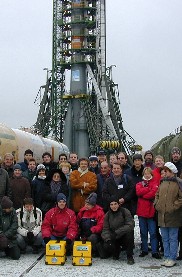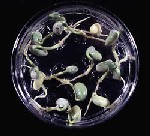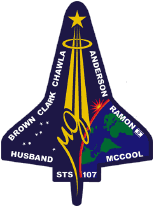| FOTON-M1 |
| The first modified new version of Foton (M1) was launched
on 15th of October 2002, from Kosmodrom Plesetsk, in the North of Russia.
On board were the first Outreach experiments designed and built by european
students: Floatin' Protein, Chondro y Winograd.
As Project Manager of the Outreach experiments, my tasks consisted on: The integration of the experiments was a complete success. The launch, in the other hand was not. A problem with one of the side boosters caused a lose of thrust and the mission ended after 29 seconds when the russian Soyuz exploded against the ground, destroying all its payload. |
 |
| Re-flying the experiments of FOTON-M1 to the ISS |
| After the Soyuz accident in October 2002, two of the experiments lost
in Foton-M1 were sent to the International Space Station (ISS) between
May and October 2003, as part of the Cervantes Mission program, with the
astronaut Pedro Duque.
Since this time the flight was manned, the experiments had to overcome a major refurbishment and adaptation in order to comply with the strict requirements applicable for this kind of missions. |
| My task consisted on the management, co-ordination and development of the experiments, as well as on the production of the official documentation and the execution of the test previous to the flight acceptance. |
| FOTON-M2 (SaySoy) |
| Scheduled for April 2005, Foton-M2 will offer a second flight opportunity to those experiments that were sadly destroyed during the accident of Foton-M1 in 2002, although it will also have some room for a few new experiments. |
|
My job on this mission is focused on the management and development of SaySoy, an autonomous experiment prepared by a team of Italian undergraduate and postgraduate students of botany. The aim of this experiment is to investigate on the possibility to germinate soy seeds in space. The success of the experiment and the good quality of the out coming sprouts could mean that they could be included on the diet of the crews for long duration missions and/or on board space stations. |
 |
| During the flight part of the experiment the seeds will germinate and after their return to Earth the sprouts will be analysed in search for possible morphological or structural modifications that may occur due to their exposition to microgravity. |
| FOTON-M3 (ERISTO and E-OSTEO) |
| The launch of Foton-M3 has been scheduled for October 2006. |
 |
For the time being I am in charge of the integration of a French-Canadian
experiment with two parts in itself: ERISTO and E-OSTEO.
This experiment already flew in 2003 on the american Space Shuttle Columbia, in the frame of the unfortunate mission STS-107, which ended in tragedy when the vehicle was disintegrated, together with her cargo and crew, during the re-entry phase. Foton will offer a second opportunity to obtain some results about the formation of bone structures in space, i.e. the subject this experiment is about. The idea consists on growing these structures in space in order to perform a study about osteoporosis. The experiment will be totally automated, monitored by telemetry, and it will be recovered after 16 days in orbit. |
| Iñaki Rodriguez Rebolledo |
|
Curriculum Vitae, 2004 |